NeuroSEE: A Neuromorphic Energy-Efficient Processing Framework for Visual Prostheses
Author (s): Wang, Chuanqing; Yang, Jie; Sawan, Mohamad
Visual prostheses with both comprehensive visual signal processing capability and energy efficiency are becoming increasingly demanded in the age of intelligent personal healthcare, particularly with the rise of wearable and implantable devices. To address this trend, we propose NeuroSEE, a neuromorphic energy-efficient processing framework that combines a spike representation encoding technique and a bio-inspired processing method. This framework first utilizes sparse spike trains to represent visual information, and then a bio-inspired spiking neural network (SNN) is adopted to process the spike trains. The SNN model makes use of an IF neuron with multiple spike-firing rates to decrease the energy consumption without compensating for prediction performance. The experimental results indicate that when predicting the response of the primary visual cortex, the framework achieves a state-of-the-art Pearson correlation coefficient performance. Spike-based recording and processing methods simplify the storage and transmission of redundant scene information and complex calculation processes. It could reduce power consumption by 15 times compared with the existing Convolutional neural network (CNN) processing framework. The proposed NeuroSEE framework predicts the response of the primary visual cortex in an energy efficient manner, making it a powerful tool for visual prostheses.

